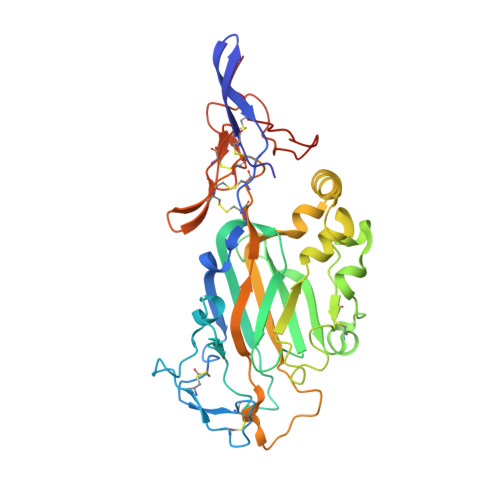Crystal structure of the ligand binding domain of netrin g2.
Brasch, J., Harrison, O.J., Ahlsen, G., Liu, Q., Shapiro, L.(2011) J Mol Biology 414: 723-734
- PubMed: 22041449
- DOI: https://doi.org/10.1016/j.jmb.2011.10.030
- Primary Citation of Related Structures:
3TBD - PubMed Abstract:
Netrin G proteins represent a small family of synaptic cell adhesion molecules related to netrins and to the polymerization domains of laminins. Two netrin G proteins are encoded in vertebrate genomes, netrins G1 and G2, which are known to bind the leucine-rich repeat proteins netrin G ligand (NGL)-1 and NGL-2, respectively. Netrin G proteins share a common multi-domain architecture comprising a laminin N-terminal (LN) domain followed by three laminin epidermal growth factor-like (LE) domains and a C' region containing a glycosylphosphatidylinositol anchor. Here, we use deletion analysis to show that the LN domain region of netrin Gs contains the binding site for NGLs to which they bind with 1:1 stoichiometry and sub-micromolar affinity. Netrin Gs are alternatively spliced in their LE domain regions, but the binding region, the LN domain, is identical in all splice forms. We determined the crystal structure for a fragment comprising the LN domain and domain LE1 of netrin G2 by sulfur single-wavelength anomalous diffraction phasing and refined it to 1.8 Å resolution. The structure reveals an overall architecture similar to that of laminin α chain LN domains but includes significant differences including a Ca(2+) binding site in the LN domain. These results reveal the minimal binding unit for interaction of netrin Gs with NGLs, define structural features specific to netrin Gs, and suggest that netrin G alternative splicing is not involved in NGL recognition.
- Department of Biochemistry and Molecular Biophysics, Columbia University, New York, NY 10032, USA.
Organizational Affiliation:




















